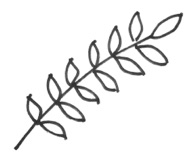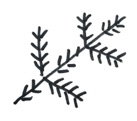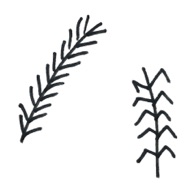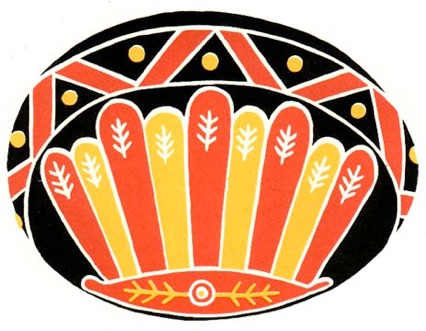Trees

Whole trees are not often seen on pysanky and, when they are, they are usually version of the tree of life (vazon). More often we see them represented on pysanky by their parts.
BRANCHES
Leaves are the most common manifestations of trees on pysanky, but they could be also represented as branches (hilky).

This is an example of a pysanka with a branch motif from the Sokal region (Korduba):

In the mountainous regions of Ukraine, pine or spruce branches were more often depicted. The evergreen nature of these plants meant they symbolized long life.

These designs on these pysanky are from western Polissia; the spruce branches are quite evident in both the Binyashevsky illustration and my re-creation:


This Hutsul pysanka, from Binyashevsky, utilizes the pine branch motif. It is found often on Hutsul pysanky, as the mountains are full of evergreen trees.

These simple pysanky, from Lvivshchyna, also demonstrate pine branches:


In other regions, the sosonka was a favorite motif. It appears similar to a pine branch, but without any branching–it is a straight line with smaller ones coming off of it. The sosonka is the horsetail plant, the first greenery to appear in the spring. It is a symbol of spring, life, rebirth.

The pysanka on the left is decorated with a sosonka motif, and is from the Lemko regions; it is an example of the drop-pull technique of pysankarstvo. On the right is an an example of sosonka from the Boiko region:


The design on the right could also be interpreted as pine or spruce branches, despite a lack of branching. More examples of sosonka motifs and information about their symbolism can be found here.
CAVEAT: Selivachov points out that, in some regions, like Poltavshchyna, the terms sosna (pine) and sosonka or sosenka were often used interchangeably, due to the similarity of their etymology. We cannot always be sure which is being referred to, unless the researcher taking down the information was punctilious about getting such botanical information.
LEAVES
Plants could be represented on in whole or in part. Most often, it was only the leaves that were depicted. They were generally elongated, and could be simple or compound, smooth or faceted.
On pysanky, flowers can often look like leaves. The two are differentiated mainly by the fact that leaves are usually solid or divided in half; they often have a central oval or other rounded shape. Flowers have petals and are more compound structures. People unfamiliar with pysanka motifs often mistake leaves for flowers.


This is an example of a simple leaf motif from Kherson:

More examples of leaf motifs and information about their symbolism can be found here.
OAKS
There were several types of leaves that were distinct and named. Oak leaves were shown with wavy contours, and sometimes interspersed with acorns. In Ancient Ukrainian mythology, the oak and its leaves symbolize Perun, the god of lightning; to honor him, the Slavs burned fires of oak logs and branches. The oak carries his attributes: strength and power.
These are examples of pysanky with the oak leaf motif from Zaporizhia and Pokuttia:


More examples of oaks and information about oak and acorn symbolism here.
BEREZIVNYK A berezivnyk is a grove of birch trees. Such groves were sacred to our pre-chirstian ancestors in Ukraine, and are sometimes depicted on pysanky. This pysanka from the Kharkiv region depicts such a grove:

Trees and their parts






